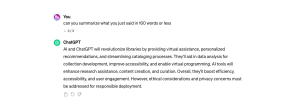AI isn’t new, but it has become more and more relevant to academia and to libraries. Enter ChatGPT. Although I had heard about ChatGPT and know of it, I never used it (this statement held true up until I starting writing this reflection. This statement is no longer true as of writing typing this sentence!)
With the art world in upheaval about AI art and the controversies that follow, (alongside the on-going debate of whether it’s original or if it’s considered “stealing”, as artists didn’t have much of a say of whether or not their art can be used), and the academia setting finding papers being written not by students, but by AI tools and technology, it’s hard to figure out just how to navigate and find a semi-working balance that allows for this to work out in the way we need it to: helpfully and efficiently.
With AI and ChatGPT now entering the chat, there are concerns, both good and bad, on how it’ll affect and impact individuals who are actively using it, and those who avoid it to not be “affected”, so to speak. I find that both sides have their pros and cons, but with the push towards a more technological age, where AI is becoming a part of the norm, perhaps it’s time to adapt. (If you can’t beat them, join them!)
When I was testing the waters with ChatGPT, I asked it this question: How do you think AI and ChatGPT will affect libraries in the future?
The reply it gave was a rather lengthy response so I said this instead:

As someone who is has been in the MLIS program for awhile now and have considered the ideas that ChatGPT had listed during my journey in the program, I am both overwhelmed and in awe at how quickly and “accurately” ChatGPT responded. This sets off a new way of “brainstorming” for ideas, especially when it comes to what libraries are going to look like in the future with the influence of AI. From what I can see, what ChatGPT has to say is not far-fetched at all. If used correctly, I believe that we can work alongside AI to truly increase accessibility and resources available to those who visit the library.
Despite the convenience of being able to simply rely on technology and AI like ChatGPT, it is best to remember that it should not be the immediate solution, and may, at times, not apply as a solution, but be more of a resource in some cases. I find that the guidelines Ethan Mollick set as expectations for his class (who are expected to use ChatGPT) to be rather relevant:
The new AI policy in my syllabus.
More on how I am integrating AI into my classes: https://t.co/EsD3MPpyVT pic.twitter.com/QfWRvuNEA5
— Ethan Mollick (@emollick) January 18, 2023
“AI is a tool”. And I agree with this statement. Use it as you will, but take it with a grain of salt.
It’s important to remember that technology and AI is developed using human expertise/information from people, which can have errors, misinformation, and biases. AI is not perfect. But neither are we. With that being said, I do think that we are beginning to see a shift in the library landscape when it comes to AI, but I believe it will be for the better, as I see it to be a tool and resource that will allow for us to better serve and create spaces for those who visit and use the library.

@donna128 This is great! I so appreciate your rumination on AI and chat GPT in particular. I have experimented a bit here and there and I agree with you about it very useful for brainstorming or getting ideas of what something might look like. Too often it sort of repeats itself. If you don’t ask correctly and I can tell the language is not human.
I’ve been mulling over how to incorporate AI into this class… Ideas welcome.